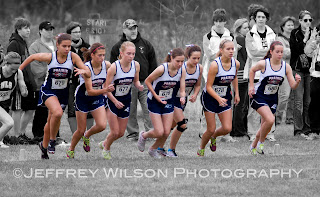 My last post showed an example of a black-and-white image. This time we're looking at a photo with selective color — that is, the photo is mostly black-and-white, but with part of the photo in color.
My last post showed an example of a black-and-white image. This time we're looking at a photo with selective color — that is, the photo is mostly black-and-white, but with part of the photo in color.Tuesday, November 2, 2010
Selective color
 My last post showed an example of a black-and-white image. This time we're looking at a photo with selective color — that is, the photo is mostly black-and-white, but with part of the photo in color.
My last post showed an example of a black-and-white image. This time we're looking at a photo with selective color — that is, the photo is mostly black-and-white, but with part of the photo in color.Wednesday, June 9, 2010
Black and white
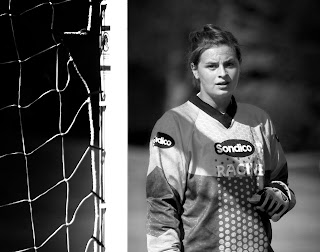
Black-and-white photographs are fun to create, as they can often capture drama and mood that is sometimes lacking in color images. What makes a good B&W image? That's too subjective to define. Key elements can include dramatic lighting, enhanced textures, and overall mood.
Wednesday, March 24, 2010
The eyes have it
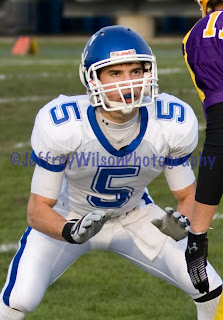
It’s certainly possible to take good sports photographs that don’t show faces, but if you want to truly capture the personality of an athlete, it’s vital to show the face, and most importantly the eyes. It's an old proverb that the eyes are the windows to the soul, and sports is no exception to the photography maxim that if you can capture the eyes, then your image will reflect the personality of a subject.
With sports, the eyes not only reflect the personality of the athlete in the photo, they—and the rest of the face—can also show the mood or feeling of the moment, whether it be excitement, hope, tension, happiness, intensity, or fear.
The key to photos like these is getting in as tight on the face as possible, which means using a long lens. I used a DSLR with a 70-200mm f/2.8 lens for all of these shots, zoomed all the way to 200mm for most.
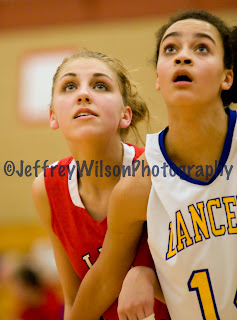
In post-processing I cropped in even tighter on them to emphasize facial expressions (see my earlier blog entry on cropping). With the action paused, you can also get away with slower shutter speeds than with action (down to 1/250 or 1/200 if necessary).
It’s difficult to do this during action while keeping the subject in focus. You’ll find it easier if you wait for pauses in play: free throws in basketball, the moment before the snap in football, a batter waiting for a pitch in baseball or softball. This also allows those with slower lenses (or point-and-shoot cameras) an opportunity to get a tight shot as well. Be aware of your vantage point: Find a spot where you can see faces clearly, and get as close to the court or field as possible.
Normally when shooting action you should use AI Servo focusing (Nikon: Continuous Servo AF) to keep the subject in focus as he or she moves.
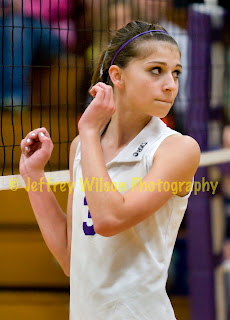
However, for shots like these, where the action is paused, a quick change to standard one-shot AF will work best. Use center-point focusing and aim at an eye—it’s the most critical element to be in focus. You can also use manual focus to make final adjustments (if you’re good at it ... which is difficult in these situations). Take several shots if possible, as it’s amazing how much the facial expression can change over a span of just a second or two.
As always, the more photos you shoot, the more keepers you’ll get. Zoom in, stay steady, and capture some great faces.
Tech info: Canon XTi with Canon 70-200mm f/2.8L lens; all at f/2.8 (various shutter speeds depending upon lighting).
Thursday, January 14, 2010
Get low to increase drama
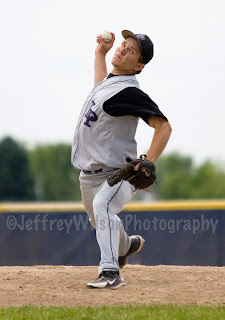
Adding feelings of drama, size, and strength to sports photos can make the difference between a snapshot and a powerful photograph. One of the best techniques for creating a dramatic sports image is to get as low as possible when taking the shot. Getting low and looking up at your subject makes the subject loom large in the photo. This is especially true when photographing youth sports. Here are photos from two high school games to illustrate the idea.
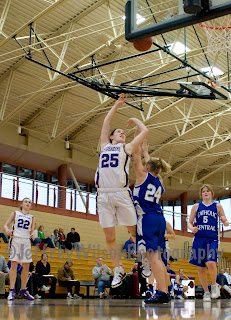
Tuesday, January 5, 2010
Panning
 Adding motion blur can be a great way to give a dynamic feel to a photo, creating the feeling that the subject is really moving. A common technique for doing this is by panning the camera, which simply means moving the camera to follow the motion of the subject while depressing the shutter button. It can work for almost any moving subject, such as cars, trains, and athletes.
Adding motion blur can be a great way to give a dynamic feel to a photo, creating the feeling that the subject is really moving. A common technique for doing this is by panning the camera, which simply means moving the camera to follow the motion of the subject while depressing the shutter button. It can work for almost any moving subject, such as cars, trains, and athletes.